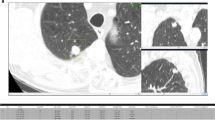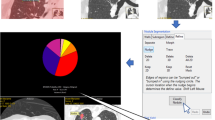Abstract
Objectives
To identify the agreement on Lung CT Screening Reporting and Data System 4X categorization between radiologists and an expert-adjudicated reference standard and to investigate whether training led to improvement of the agreement measures and diagnostic potential for lung cancer.
Methods
Category 4 nodules in the Korean Lung Cancer Screening Project were identified retrospectively, and each 4X nodule was matched with one 4A or 4B nodule. An expert panel re-evaluated the categories and determined the reference standard. Nineteen radiologists were asked to determine the presence of CT features of malignancy and 4X categorization for each nodule. A review was performed in two sessions, and training material was given after session 1. Agreement on 4X categorization between radiologists and the expert-adjudicated reference standard and agreement between radiologist-assessed 4X categorization and lung cancer diagnosis were evaluated.
Results
The 48 expert-adjudicated 4X nodules and 64 non-4X nodules were evenly distributed in each session. The proportion of category 4X decreased after training (56.4% ± 16.9% vs. 33.4% ± 8.0%; p < 0.001). Cohen’s κ indicated poor agreement (0.39 ± 0.16) in session 1, but agreement improved in session 2 (0.47 ± 0.09; p = 0.03). The increase in agreement in session 2 was observed among inexperienced radiologists (p < 0.05), and experienced and inexperienced reviewers exhibited comparable agreement performance in session 2 (p > 0.05). All agreement measures between radiologist-assessed 4X categorization and lung cancer diagnosis increased in session 2 (p < 0.05).
Conclusion
Radiologist training can improve reader agreement on 4X categorization, leading to enhanced diagnostic performance for lung cancer.
Key Points
• Agreement on 4X categorization between radiologists and an expert-adjudicated reference standard was initially poor, but improved significantly after training.
• The mean proportion of 4X categorization by 19 radiologists decreased from 56.4% ± 16.9% in session 1 to 33.4% ± 8.0% in session 2.
• All agreement measures between the 4X categorization and lung cancer diagnosis increased significantly in session 2, implying that appropriate training and guidance increased the diagnostic potential of category 4X.






Similar content being viewed by others
Abbreviations
- AC1 :
-
First-order agreement coefficient
- K-LUCAS:
-
Korean Lung Cancer Screening Project
- Lung-RADS:
-
Lung CT Screening Reporting and Data System
References
de Koning HJ, van der Aalst CM, de Jong PA et al (2020) Reduced lung-cancer mortality with volume CT screening in a randomized trial. N Engl J Med 382:503–513
National Lung Screening Trial Research Team, Aberle DR, Adams AM et al (2011) Reduced lung-cancer mortality with low-dose computed tomographic screening. N Engl J Med 365:395–409
Pastorino U, Silva M, Sestini S et al (2019) Prolonged lung cancer screening reduced 10-year mortality in the MILD trial: new confirmation of lung cancer screening efficacy. Ann Oncol 30:1162–1169
American College of Radiology (2014) Lung CT Screening Reporting & Data System (Lung-RADS) version 1.0. Available via https://www.acr.org/-/media/ACR/Files/RADS/Lung-RADS/LungRADS_AssessmentCategories.pdf?la=en. Accessed July 01 2019
Mehta HJ, Mohammed TL, Jantz MA (2017) The American College of Radiology Lung Imaging Reporting and Data System: potential drawbacks and need for revision. Chest 151:539–543
McKee BJ, Regis SM, McKee AB, Flacke S, Wald C (2015) Performance of ACR Lung-RADS in a clinical CT lung screening program. J Am Coll Radiol 12:273–276
Pinsky PF, Gierada DS, Black W et al (2015) Performance of Lung-RADS in the National Lung Screening Trial: a retrospective assessment. Ann Intern Med 162:485–491
van Riel SJ, Jacobs C, Scholten ET et al (2019) Observer variability for Lung-RADS categorisation of lung cancer screening CTs: impact on patient management. Eur Radiol 29:924–931
Chung K, Jacobs C, Scholten ET et al (2017) Lung-RADS category 4X: does it improve prediction of malignancy in subsolid nodules? Radiology 284:264–271
Kim H, Kim HY, Goo JM, Kim Y (2020) Lung cancer CT screening and Lung-RADS in a tuberculosis-endemic country: the Korean Lung Cancer Screening Project (K-LUCAS). Radiology 296:181–188
Nair A, Bartlett EC, Walsh SLF et al (2018) Variable radiological lung nodule evaluation leads to divergent management recommendations. Eur Respir J 52:1801359
Lee J, Lim J, Kim Y et al (2019) Development of protocol for Korean Lung Cancer Screening Project (K-LUCAS) to evaluate effectiveness and feasibility to implement national cancer screening program. Cancer Res Treat 51:1285–1294
Hwang EJ, Goo JM, Kim HY, Yi J, Yoon SH, Kim Y (2021) Implementation of the cloud-based computerized interpretation system in a nationwide lung cancer screening with low-dose CT: comparison with the conventional reading system. Eur Radiol 31:475–485
Suh YJ, Lee JW, Shin SY, Goo JM, Kim Y, Yong HS (2020) Coronary artery calcium severity grading on non-ECG-gated low-dose chest computed tomography: a multiple-observer study in a nationwide lung cancer screening registry. Eur Radiol 30:3684–3691
Hwang EJ, Goo JM, Kim HY et al (2020) Variability in interpretation of low-dose chest CT using computerized assessment in a nationwide lung cancer screening program: comparison of prospective reading at individual institutions and retrospective central reading. Eur Radiol. https://doi.org/10.1007/s00330-020-07424-1
Kim H, Kim HY, Goo JM, Kim Y (2020) External validation and comparison of the Brock model and Lung-RADS for the baseline lung cancer CT screening using data from the Korean Lung Cancer Screening Project. Eur Radiol. https://doi.org/10.1007/s00330-020-07513-1
Martin MD, Kanne JP, Broderick LS, Kazerooni EA, Meyer CA (2017) Lung-RADS: pushing the limits. Radiographics 37:1975–1993
McWilliams A, Tammemagi MC, Mayo JR et al (2013) Probability of cancer in pulmonary nodules detected on first screening CT. N Engl J Med 369:910–919
Erasmus JJ, Connolly JE, McAdams HP, Roggli VL (2000) Solitary pulmonary nodules: part I. morphologic evaluation for differentiation of benign and malignant lesions. Radiographics 20:43–58
Gurney JW (1993) Determining the likelihood of malignancy in solitary pulmonary nodules with Bayesian analysis. Part I. Theory. Radiology 186:405–413
Zwirewich CV, Vedal S, Miller RR, Muller NL (1991) Solitary pulmonary nodule: high-resolution CT and radiologic-pathologic correlation. Radiology 179:469–476
Kui M, Templeton PA, White CS, Cai ZL, Bai YX, Cai YQ (1996) Evaluation of the air bronchogram sign on CT in solitary pulmonary lesions. J Comput Assist Tomogr 20:983–986
Fleiss JL, Levin B, Paik MC (2003) Statistical methods for rates and proportions, 3rd edn. Wiley, New York
Giacalone M, Agata Z, Cozzucoli PC, Alibrandi A (2018) Bonferroni-Holm and permutation tests to compare health data: methodological and applicative issues. BMC Med Res Methodol 18:81
Bender R, Lange S (2001) Adjusting for multiple testing--when and how? J Clin Epidemiol 54:343–349
Henschke CI, Yankelevitz DF, Mirtcheva R et al (2002) CT screening for lung cancer: frequency and significance of part-solid and nonsolid nodules. AJR Am J Roentgenol 178:1053–1057
Scholten ET, de Jong PA, de Hoop B et al (2015) Towards a close computed tomography monitoring approach for screen detected subsolid pulmonary nodules? Eur Respir J 45:765–773
American College of Radiology (2019) ACR lung cancer screening webinars. Available via https://www.acr.org/Advocacy-and-Economics/Advocacy-News/Advocacy-News-Issues/In-the-August-31-2019-Issue/ACR-Lung-Cancer-Screening-Webinars-Now-Available. Accessed August 24 2020
Pinsky PF, Church TR, Izmirlian G, Kramer BS (2013) The National Lung Screening Trial: results stratified by demographics, smoking history, and lung cancer histology. Cancer 119:3976–3983
Funding
This study was supported by grants from the National R&D Program for Cancer Control, Ministry of Health and Welfare (1720310, 1520230) and National Health Promotion Fund (1760810-1), Ministry of Health and Welfare, Republic of Korea.
Author information
Authors and Affiliations
Corresponding author
Ethics declarations
Guarantor
The scientific guarantor of this publication is Jin Mo Goo.
Conflict of interest
Activities related to the present article: none.
Activities not related to the present article: HK received a research grant from Lunit; holds stock in Medical IP. JMG received research grants from Lunit, INFINITT Healthcare, Dongkook Lifescience, and LG electronics.
Statistics and biometry
No complex statistical methods were necessary for this paper.
Informed consent
Written informed consent was not required because this study retrospectively analyzed anonymized data, which was archived from a prospective cohort.
Ethical approval
An exemption from the institutional review board of Seoul National University Hospital was acquired for this retrospective analysis (E-2008-157-1151).
Study subjects or cohorts overlap
Some study subjects or cohorts have been previously reported
Radiology 2020;296(1):181-188;
Eur Radiol 2020;30(7):3684-3691;
Eur Radiol doi: 10.1007/s00330-020-07151-7;
Eur Radiol doi: 10.1007/s00330-020-07424-1
Methodology
• retrospective
• diagnostic or prognostic study
• multicenter study
Additional information
Publisher’s note
Springer Nature remains neutral with regard to jurisdictional claims in published maps and institutional affiliations.
Supplementary information
ESM 1
(DOCX 507 kb)
Rights and permissions
About this article
Cite this article
Kim, H., Goo, J.M., Kim, T.J. et al. Effectiveness of radiologist training in improving reader agreement for Lung-RADS 4X categorization. Eur Radiol 31, 8147–8159 (2021). https://doi.org/10.1007/s00330-021-07990-y
Received:
Revised:
Accepted:
Published:
Issue Date:
DOI: https://doi.org/10.1007/s00330-021-07990-y




